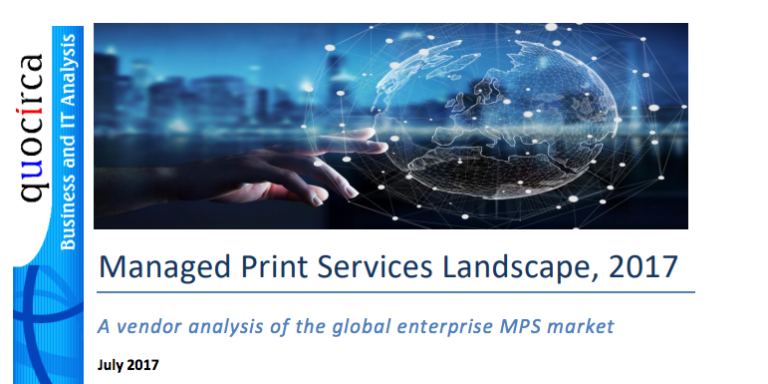Observers say the MPS market is mature, meaning most customers understand the worth of services like device optimization and fleet management. What may be less understood is the value of MPS as a bridge to “didge,” digital transformation, that is. In the right hands, MPS is a platform for innovation and a path from paper to digital.
Here are 14 ways your MPS engagement has value that goes beyond the basic level of services to take you on a digital journey.
1. MPS already touches most if not all of your document-based processes – the ones most ripe for digital transformation.
It’s hard to separate MPS from the document lifecycle, since MPS devices operate at critical junctures of many document processes. As you move through the three-stage Next Gen MPS continuum, the focus shifts from devices and printing to capture and content. Paper-heavy processes become easier to spot and automate.
2. There’s hope for hybrid digital and paper-based document workflow.
MPS capabilities can help you deal with the challenges of “bimodal documents,” the hybrid digital and paper environments that can sidetrack your digital plans. Hybrid environments remain a reality, as business documents often go from analog to digital multiple times in their life cycle. Even digitally run operations must occasionally deal with printed documents from outsiders like customers and suppliers.
3. A ready platform for innovation
Do you have an MPS contract and a fleet of MFPs? Do those devices have a common user interface to authenticate users and customize apps? If so, you already have the on-ramp to digital workflow and a platform for continuous innovation. When you can build onto your MPS environment to improve workflow and manage documents, you have one less platform to complicate your digital journey.
4. Easy to integrate changes and improvements into existing systems
Next Gen MPS has always had the goal of minimal disruption and this carries over into the digital journey. MPS platforms are designed to integrate with your existing systems, not pressure you into more change than your organization can tolerate. As enterprises wean off paper, or what’s more likely, come to terms with hybrid paper and digital document environments, a forward-looking MPS strategy leverages the environment you have to get to the digital workplace you want.
5. Finding the cure for Bimodal IT
As you push to bring fresh innovation and up-to-date security to your customers, your organization still depends on your legacy systems and practices. It’s the bimodal IT dilemma of keeping the old, while preparing for the new. For the time being, you must manage both environments, but if you have an MPS contract, you have a surprisingly good resource not just to cope with bimodal IT, but build on it. MPS brings tools and expertise to help you in both business stability and agility. MPS provides a reliable resource for day-to day document challenges, as well as lighting a path to greater automation and digital transformation.
6. MPS savings free up funding for digital innovation.
Most IT organizations would willingly devote more time and resources to digital initiatives if they could afford it. As the organization demands more innovation and services, the IT budget is shrinking, consumed by operating costs and legacy apps. IT needs to squeeze costs to fund innovation, and MPS provides a solution. As MPS racks up cost reductions — as high as the notorious 30 percent — more funds – and a common platform – become available for digital initiatives in process automation, security, mobility, epublishing and more.
7. You can make progress in stages.
Going digital isn’t an overnight makeover of your current state, and sometimes, a gradual transition is better. MPS doesn’t require the overhaul of big chunks of infrastructure to add document and process innovation. A three-stage Next Gen MPS approach tackles problems gradually in prescribed steps to reduce the disruption and pain of change. This forward-looking MPS path gives you breathing room as you undergo transition, while minimizing disruption. New digital capabilities are built up from the foundation of your MPS framework.
8. An end-to-end view of your business opens the door for wide-ranging but holistic digitization.
While typical MPS engagements starts and stays with office printing, a Next Gen MPS provider can take digitization beyond that into many areas of your business where documents live and flow. An elite class of MPS providers will outline a digital journey that goes from office productivity to print room efficiency.
9. As you progress, MPS keeps the device fleet in line with actual business needs.
As your digital and automation footprint expands, you may print less. MPS slims down your fleet to prepare you for the next generation of document needs. Your MPS vendor will continuously optimize your fleet size, so you’re not stuck with several years of leases just as you’re ready to start digitizing content and reducing your print output. Your MPS provider should be very strategic about what equipment to keep in place and ensuring flexibility in your contract.
10. MPS providers offer document analytics and workflow analysis to guide digital decisions.
Your MPS engagement provides access to a variety of data that reveals opportunities for improvements in the traditional document space, and also spotlights potential innovation going forward. Your digital progress is based on reality, not intuition.
11. MPS is no stranger to security.
Just like print, digital workflow requires solutions for securing, sharing and accessing documents inside and outside your organization. These requirements are already part of the MPS value prop, and remain in place as MPS provides the bridge between device-level security and the beginning of digital workflow. For example, one MPS common security practice is that users be authenticated as they scan information at a device. Your MPS provider has been all over document security from the start of your engagement, and there’s no reason to stop as you get farther along in your digital journey. Document and information security are built in at every stage. Expect your MPS partner to keep a protective eye on your business information, as they expand automation and digital tools within your organization.
12. You learn from industry benchmarks for MPS-driven innovation and digitization.
Enterprises operate at a disadvantage when they don’t know how they compare with similar companies for certain business processes. Next Gen MPS providers are in a unique position to help clients see how they stack up. They can share industry benchmarks for MPS-driven innovation and digitization. They can devise a professional plan to leverage technology and best practices to help you compete more effectively.
13. Your MPS partner constantly evaluates your current state and proactively points to continuous improvement and innovation.
Innovation is how Next Gen MPS providers deliver transformative value to enterprises, and the Quarterly Business Review (QBR) makes this a repeatable, data-driven process. Does your provider proactively schedule these sessions and bring fresh ideas to the table, based on data and understanding of your unique reality?
14. Your MPS partner has been down this path before and can guide you.
Digital transformation is new territory, yet we all have to get there one way or another. As you embark on your unique journey, it’s important to have a guide. The goal of Next Gen MPS partners is to steer you along an ever-more innovative roadmap to the digital workplace that’s right for your organization. Progressive Next Gen MPS programs are designed take you through the three stages, from assess and optimize, to secure and integrate to automate and simplify. We’re tuned in to digital ways of work and understand how to leverage MPS as a platform for innovation. We share the vision of a digitally enabled workplace and workforce. Even though everyone is at a different place on their digital journey, we can bridge the gap from where you are now to where you want to be as a digitally empowered company.



